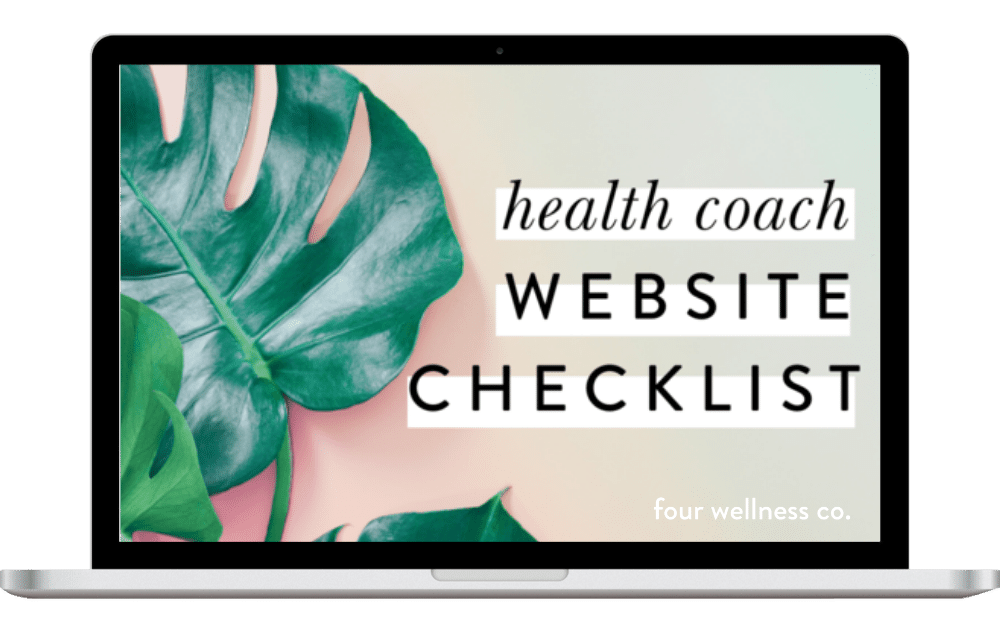How to Improve SEO on Your Health Coaching Website
This post contains affiliate links, through which we may earn a small commission if you choose to purchase, at no additional cost to you. We only share products or services we personally use & recommend!
As you’ve been building your health coaching business and website, you may have heard about “SEO” or “search engine optimization” and how important it is for growing your business and putting your content and services in front of new prospective health coaching clients.
Search engine optimization (SEO) is a massive and complex topic, and there are entire agencies that make their income helping business owners improve SEO. So, keep in mind there’s a lot more that can be said about it than what I can cover in one blog post!
That said, there are a few primary pieces of information to know about SEO as it relates to your health coaching business—so you can keep those in mind as you build (or improve upon) your health coaching website.
Here’s what health coaches should know about SEO:
What is SEO + why does it matter for health coaches?
Search engine optimization (SEO) is the process of—well—optimizing your content’s visibility in search engine rankings.
That means, putting your content in front of the exact people who are looking for just that.
For example: You write a helpful blog post about a certain wellness topic. When someone searches Google with keywords regarding that topic, you want your lovely blog post to show up near the top of the list of search results, so that person will see it, click on it, and ultimately read your wonderful, helpful blog post.
The reason SEO is a process is that there are various elements that can be strategically addressed throughout your content creation and promotion that will enhance your visibility to search engines and encourage them to rank you higher.
In general, search engine algorithms look kindly on the following things:
relevant long-form content (greater than about 1,200 words)
relevant titles
relevant links
well-labeled images
referring links (the number of links across the web that link to your page)
mobile responsive design
page loading speed
Side note: Though Google is still the crowned king of online search engines, it’s certainly not the only one, and an increasing number of searches are taking place on mobile via voice-activated searching with Siri and Alexa, which use Apple and Amazon search engines respectively.
How to boost your health coaching website’s SEO
As a health coach or wellness professional, here’s what you need to know about setting up your website’s SEO, and continuing to grow it over time.
Note: These SEO tips are outlined for Squarespace websites (the platform I use and recommend!). The same tips apply to other website platforms as well (WordPress, Wix, Weebly, etc.), though the back-end implementation may be a bit different.
Write relevant, keyword-rich page titles
Search engines prioritize page titles, blog post titles and the like, so it’s important to write clear and descriptive, keyword-rich titles that will help both humans and search engines find the content they’re looking for on your website.
Squarespace page settings allow you to easily update (and differentiate) your SEO titles, navigation titles and page titles. Here’s the difference:
SEO title: indexed by search engines and appears in search results, so this is where you’ll want to add keywords you’d like the search engine to find and display to people searching for your content
Navigation title: links to the page in your navigation menus (so you’ll want to keep it brief, like “About” or “Blog”)
Page title: this allows you to use a different, usually longer, title in your browser tab than on your navigation menu (for example, “Services” on the nav menu could become “Health Coaching Services” on the page title); note that if you don’t customize your SEO title, your page title will appear in search results
Understand (+ maximize) your page metadata
There are a couple other elements of page metadata that can impact your search ranking:
SEO page description
Squarespace also includes SEO descriptions (and page descriptions on some templates). These descriptions appear below your page title in search engine listings—which means prospective readers will likely be using them to determine if they’d like to click on your link.
For each page on your website, write a strategic, keyword-rich SEO description that describes the content on that page. Find these settings in Page > SEO > SEO Description. Find the SEO description for your entire site in Marketing > SEO > Site Meta Description.
URL
To improve how search engines are able to crawl and index your site, use clear, descriptive and clean URLs. This means each page URL should contain relevant keywords for your page content, be as brief as possible and contain no spelling errors.
In some cases, like with blog post settings, you may want to clean up any unnecessary information (like the date) to optimize your blog post URLs.
Structure content with keyword-rich headings
Just like they do with titles, search engines prioritize the headings on your site over its body content. Thus, your headings are important in letting search engines know the major themes of your site, and the specific content of each page.
Use your site’s built-in headings (h1, h2, h3) to structure your content in a hierarchical order (h1 being the highest). And, be mindful of how you write headings: they should be clear and descriptive, with keywords from each page’s topic.
This is not to say you should simply structure headings for search engines—they also serve an important purpose for guiding readers through your content. Many readers will scan a post before choosing to dive in and read it in its entirety.
Update your image alt-text
Search engines can’t read photos, they can only read text—so adding alt-text captions to your images helps search engines to “see” them and understand their content.
In Squarespace, you can add alt-text to most images, including those in image blocks, galleries and product images.
For image blocks, add a caption to the image and select “do not display caption” (though if you want to display the caption, that’s fine too, and it will still be indexed as alt-text).
For galleries and products, the alt-text can be added to the “Image Title” field in the image settings.
For blog post thumbnails, the blog post title is the default alt-text.
Note that image alt-text is also carried along with the image as the default caption if someone pins an image from your website to Pinterest. (So, strategically captioning images with alt-text is an element of your Pinterest SEO too!)
Blog, blog, blog!
Blogging is one of the best strategies to boost SEO and grow traffic to your website.
Blogging is great for your health coaching website’s SEO in several ways:
it adds more relevant wellness content to your site (so you have more opportunities to establish your particular health coaching themes and keywords with search engines)
it shows search engines your site is active and regularly updated
it’s more shareable than the average webpage, so can help spread your content better
Even if you don’t think of yourself as “a wellness blogger,” it’s beneficial to include a wellness blog on your website for these purposes. You don’t have to post daily or write novel-length posts—just regular (weekly or bi-weekly) posts can help to improve your SEO.
Pro tip: The CoSchedule Headline Analyzer is a useful tool for testing the SEO-friendliness of different blog post titles.
Strategically use categories + tags
Whether on your blog, products or galleries, Squarespace’s built-in category and tag features can help search engines accurately identify your content, improving its visibility.
Improve your SEO by adding relevant category and tag labels to any of your site elements that include this feature: blog posts, products, gallery images, etc.
Perfect your health coaching website
Grab my free checklist for optimizing your wellness website!
It’s got all the big picture must-haves (& all the important little details!) to make your health coach website shine. ✨
Use plenty of internal links
To make the search engine gods happy, you want to have links pointing to your content. It’s great if these links are coming from large, highly trafficked sources (like if a popular wellness publication links to you), but often that is a bit out of your control.
(Well, it’s in your control to write high quality blog content and promote your blog to new audiences, which will improve your chances…but you can’t totally control the number of referring links that will result in.)
So, another way to grow the number of backlinks to your pages is to link to them yourself, as relevant. (And this also serves the dual purpose of helping your readers better find additional content they’d also be interested in!)
When linking to your own content, it’s best to use descriptive words in your anchor text (the highlighted text you’re linking from) that give a sense of the topic you’re linking to. For example, instead of saying “We share business tips and resources for health coaches here,” it’d be better to say “Here’s our archive of business tips and resources for health coaches.”
A note on quality health coaching website content
In addition to these back-end tips for optimizing your health coaching website’s SEO, it’s also important to remember that your content matters in SEO ranking.
The purpose of a search engine algorithm is to provide the most relevant content possible to the person searching for it. So, quality content (whether that’s a blog post, webpage, gallery, whatever) is essential to good SEO strategy.
Search engines are getting better and better at prioritizing quality and relevant content. Your best bet for strong SEO is to focus on producing useful and well-constructed content for your target audience and promoting it with the methods above, using keywords that your target audience would actually use to search for it.
One of the reasons I recommend Squarespace as a website platform for health coaches is that it makes SEO very simple for beginners. While the world of SEO is certainly much larger than what I’ve covered here, if you follow the tips mentioned above you’ll be setting yourself up well for SEO success!
SEO basics for health coaches
P.S. If you’re interested in knowing even more about maximizing SEO to grow an audience for your health coaching practice, I put together a complete SEO Basics for Business Owners training with step-by-step instructions on:
finding your business’ primary keywords
all the important places to add those keywords around your website
crafting your website content to attract your target audience’s actual search queries (aka providing answers to their problems!)
and best practices for continuing to grow your website’s SEO over time.
Use code HEALTHCOACH for 20% off!















